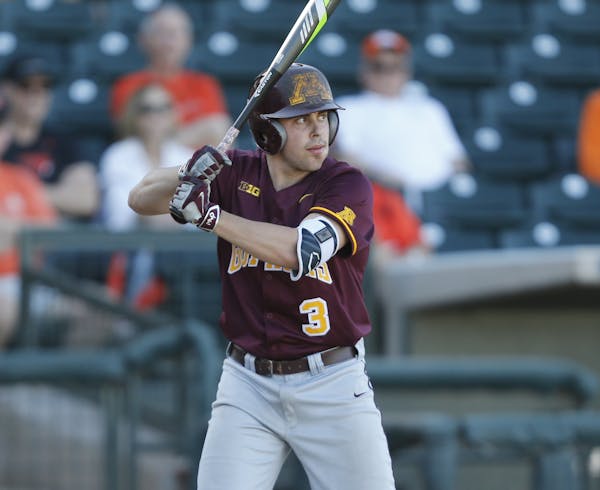The Gophers head to Northwestern for a Friday-Sunday series this week rated 25th in Division I baseball. They have won 12 of the past 14, are 6-2 in the Big Ten and a half-game out of first place.
In softball, the Gophers host Nebraska for a three-game series starting Friday and are rated 23rd. They are 30-12 overall, 11-3 in the Big Ten and a game out of first.
Continued success in baseball and softball would assist in allowing the Gophers to maintain a lofty position (they are fourth after fall and winter sports) in the Director's Cup, which measures the overall success of all NCAA Division I athletic programs.
These teams are more representative of what has happened with University of Minnesota athletics in this school year than what occurred with the large moneymakers, Gophers football and men's basketball, when those two programs were a combined 4-23 against Big Ten competition.
It has been opined regularly that the Gophers are an athletic department in chaos, based on three factors:
One, the cumbersome and ongoing search for a new athletic director that has followed the firing of Norwood Teague for conduct unbecoming a person of the male gender.
Two, the worst season in the 120-year history of men's basketball, culminated with the suspension of three players after the posting of a sex video on social media.
Three, a popular belief with the sporting public that university President Eric Kaler has to be some type of stooge, both for signing off on a new contract that gave basketball coach Richard Pitino a $7 million buyout at this point in his failed tenure, and Kaler's inability to make a deal with resigned football coach Jerry Kill to stay active in Gophers athletics.
As we in the media focus on what appears to be trauma, a case can be made that Gophers athletics as a whole are in better shape competitively than at any time since Title IX changed the requirements for sponsoring sports 40 years ago.
There were years — maybe even a couple of decades — when fools such as myself saw trying to create a facsimile of equity for women athletes as an unnecessary burden to place on the Gophers as they tried to gain a higher stature in Big Ten football and men's basketball.
You look now, and the ability of this state university with 50,000 students to provide a full-service athletic department should be the real source of pride for alums and other Gophers loyalists.
There is a combination of coaches — both institutions and relative newcomers — who are responsible for making success a common theme for U of M teams. For instance:
John Anderson will be overseeing games Nos. 2011 through 2013 as the Gophers' head baseball coach this weekend in Evanston, Ill. And assistant Rob Fornasiere will be involved in his 1,800th game Friday night.
Anderson's fundraising and that of other baseball people led to a new Siebert Field, and now there's a new on-site hitting facility to go with it. Next season, there will be a new Vikings' stadium to play some early-season games and return travel costs to normalcy.
For now, the Gophers have rallied from a rare flop of a season, a ninth-place finish in 2015, to regain their competitiveness. Baseball is the oldest program on campus, it long has been a positive for Gophers sports, and it will remain so.
In contrast to Anderson being in his 35th season, softball coach Jessica Allister is in her sixth, a Joel Maturi hire who has done amazing work in taking the Gophers from the depths of the Big Ten to being strong contenders and regulars in the NCAA tournament.
Officially, the university credits itself with providing 25 varsity sports, but that includes cross country, track and field and indoor track as separate entities for men and women.
You can take those six sports teams and more accurately figure them as two. Steve Plasencia is the director of all three track activities for the men, and Matt Bingle for the women.
The 21 sports include tennis and golf for men and women, with small rosters and head coaches who aren't exactly getting rich.
People enjoying making jokes about the "boathouse'' that was erected for women's rowing, but the scholarships are minimal, it gives a few dozen students a chance to compete in the fall and spring, and it doesn't make any size of a dent in the Gophers' bottom line.
There are 730 athletes in the varsity programs, with 509 of those sharing the equivalent of 310 scholarships. These included the full scholarships mandate by the NCAA for football, men's and women's basketball and a couple other sports.
This was the first year of the NCAA's "cost of attendance" initiative for Division I athletics. The add-on in 2015-16 for the Gophers above a full scholarship was $3,700, and that was given out on the basis of percentage of scholarship.
The cost was slightly over $1 million — chump change in the overall budget when you consider that Commissioner Jim Delany is in the process of putting together new network TV deals for football and basketball that will push the take to $40 million per Big Ten team starting with the 2017-18 athletic seasons. That doesn't count what the Gophers will be hauling in as their share from the Big Ten Network.
There are no longer reasons for class warfare between the big earners/big spenders and the "nonrevenue" sports at Minnesota.
And in the second case, there are plenty of reasons to celebrate.
Patrick Reusse can be heard 3-6 p.m. weekdays on AM-1500. • preusse@startribune.com
Reusse: Shaver was 'Voice of the North Stars' and an all-time great guy

Reusse: There's no doubt Finch is the right coach for the Wolves

Reusse: How bad are the White Sox? They made Twins look good.

Reusse's Tortured Columnist Department update: Yes, Vikings won the offseason


